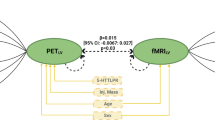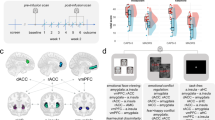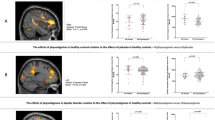Abstract
The processing of affective material is known to be modulated by serotonin (5-HT), but few studies have used neurophysiological measures to characterize the effect of changes in 5-HT on neural responses to emotional stimuli. We used functional magnetic resonance imaging to investigate the effect of acute tryptophan depletion, which reduces central 5-HT synthesis, on neural responses to emotionally valenced verbal stimuli. Though no participants experienced significant mood change, emotional information processing was substantially modified following 5-HT depletion. A behavioral bias toward positive stimuli was attenuated following depletion, which was accompanied by increased hemodynamic responses during the processing of emotional words in several subcortical structures. Inter-individual differences in tryptophan depletion-elicited anxiety correlated positively with the caudate bias toward negative stimuli. These data suggest that 5-HT may play an important role in mediating automatic negative attentional biases in major depression, as well as resilience against negative distracting stimuli in never-depressed individuals.
Similar content being viewed by others
Log in or create a free account to read this content
Gain free access to this article, as well as selected content from this journal and more on nature.com
or
References
Andrade R (1998). Regulation of membrane excitability in the central nervous system by serotonin receptor subtypes. Ann N Y Acad Sci 861: 190–203.
Bell CJ, Hood SD, Nutt DJ (2005). Acute tryptophan depletion. Part II: clinical effects and implications. Aust N Z J Psychiatry 39: 565–574.
Booij L, Van der Does W, Benkelfat C, Bremner JD, Cowen PJ, Fava M et al (2002). Predictors of mood response to acute tryptophan depletion. A reanalysis. Neuropsychopharmacology 27: 852–861.
Brown JW, Braver TS (2005). Learned predictions of error likelihood in the anterior cingulate cortex. Science 307: 1118–1121.
Cato MA, Crosson B, Gokcay D, Soltysik D, Wierenga C, Gopinath K et al (2004). Processing words with emotional connotation: an FMRI study of time course and laterality in rostral frontal and retrosplenial cortices. J Cogn Neurosci 16: 167–177.
Charney DS, Drevets WC (2002). The neurobiological basis of anxiety disorders. In: Davis KL, Charney DS, Coyle JT, Nemeroff CB (eds). Neuropsychopharmacology. The Fifth Generation of Progress. Lippincott, Williams & Wilkins: Philedelphia. pp 910–930.
Cools R, Blackwell A, Clark L, Menzies L, Cox S, Robbins TW (2005a). Tryptophan depletion disrupts the motivational guidance of goal-directed behavior as a function of trait impulsivity. Neuropsychopharmacology 30: 1362–1373.
Cools R, Calder AJ, Lawrence AD, Clark L, Bullmore E, Robbins TW (2005b). Individual differences in threat sensitivity predict serotonergic modulation of amygdala response to fearful faces. Psychopharmacology (Berl) 180: 670–679.
Deutch AY, Roth RH (1990). The determinants of stress-induced activation of the prefrontal cortical dopamine system. Prog Brain Res 85: 367–402;discussion 402–403.
Drevets WC (2000). Neuroimaging studies of mood disorders. Biol Psychiatry 48: 813–829.
Drevets WC, Bogers W, Raichle ME (2002). Functional anatomical correlates of antidepressant drug treatment assessed using PET measures of regional glucose metabolism. Eur Neuropsychopharmacol 12: 527–544.
Drevets WC, Gautier C, Price JC, Kupfer DJ, Kinahan PE, Grace AA et al (2001). Amphetamine-induced dopamine release in human ventral striatum correlates with euphoria. Biol Psychiatry 49: 81–96.
Drevets WC, Price JC (2005). Neuroimaging and neuropathological studies of mood disorders. In: Licinio J, Wong ML (eds). Biology of Depression: From Novel Insights to Therapeutic Strategies. Wiley-VCH Verlag GmbH & Co.: Weinheim, Germany. pp 427–466.
Drevets WC, Raichle ME (1992). Neuroanatomical circuits in depression: implications for treatment mechanisms. Psychopharmacol Bull 28: 261–274.
Drevets WC, Videen TO, Price JL, Preskorn SH, Carmichael ST, Raichle ME (1992). A functional anatomical study of unipolar depression. J Neurosci 12: 3628–3641.
Elliott R, Rubinsztein JS, Sahakian BJ, Dolan RJ (2000). Selective attention to emotional stimuli in a verbal go/no-go task: an fMRI study. Neuroreport 11: 1739–1744.
Elliott R, Rubinsztein JS, Sahakian BJ, Dolan RJ (2002). The neural basis of mood-congruent processing biases in depression. Arch Gen Psychiatry 59: 597–604.
Erickson K, Drevets WC, Clark L, Cannon DM, Bain EE, Zarate Jr CA et al (2005). Mood-congruent bias in affective go/no-go performance of unmedicated patients with major depressive disorder. Am J Psychiatry 162: 2171–2173.
Furst P, Pollack L, Graser TA, Godel H, Stehle P (1990). Appraisal of four pre-column derivatization methods for the high-performance liquid chromatographic determination of free amino acids in biological materials. J Chromatogr 499: 557–569.
Hamilton M (1959). The assessment of anxiety states by rating. Br J Med Psychol 32: 50–55.
Hamilton M (1960). A rating scale for depression. J Neurol, Neurosurg Psychiatry 23: 56–62.
Harmer CJ, Mackay CE, Reid CB, Cowen PJ, Goodwin GM (2006). Antidepressant drug treatment modifies the neural processing of nonconscious threat cues. Biol Psychiatry 59: 816–820.
Harmer CJ, Rogers RD, Tunbridge E, Cowen PJ, Goodwin GM (2003). Tryptophan depletion decreases the recognition of fear in female volunteers. Psychopharmacology (Berl) 167: 411–417.
Hollon SD, Kendall PC (1980). Cognitive self-statements in depression: development of an automatic thoughts questionnaire. Cogn Ther Res 4: 383–395.
Howell DC (2002). Statistical Methods for Psychology, 5th edn. Duxbury Press: London.
Inoue T, Tsuchiya K, Koyama T (1994). Regional changes in dopamine and serotonin activation with various intensity of physical and psychological stress in the rat brain. Pharmacol Biochem Behav 49: 911–920.
Jacobs BL, Azmitia EC (1992). Structure and function of the brain serotonin system. Physiol Rev 72: 165–229.
Knutson B, Fong GW, Bennett SM, Adams CM, Hommer D (2003). A region of mesial prefrontal cortex tracks monetarily rewarding outcomes: characterization with rapid event-related fMRI. NeuroImage 18: 263–272.
Kondo H, Saleem KS, Price JL (2005). Differential connections of the perirhinal and parahippocampal cortex with the orbital and medial prefrontal networks in macaque monkeys. J Comp Neurol 493: 479–509.
Kuchinke L, Jacobs AM, Grubich C, Võ ML-H, Conrad M, Herrmann M (2005). Incidental effects of emotional valence in single word processing: an fMRI study. NeuroImage 28: 1022–1032.
Maddock RJ, Garrett AS, Buonocore MH (2003). Posterior cingulate cortex activation by emotional words: fMRI evidence from a valence decision task. Hum Brain Mapp 18: 30–41.
Mai JK, Assheuer J, Paxinos G (2003). Atlas of the Human Brain, 2nd edn. Academic Press: San Diego.
Maxwell E (1992). Family Interview for Genetic Studies (FIGS) A Manual for FIGS. Clinical Neurogenetics Branch, Intramural Research Program, National Institute of Mental Health: Bethesda, MD.
Mayberg HS, Liotti M, Brannan SK, McGinnis S, Mahurin RK, Jerabek PA et al (1999). Reciprocal limbic-cortical function and negative mood: converging PET findings in depression and normal sadness. Am J Psychiatry 156: 675–682.
McNair DM, Lorr M, Droppleman LF (1971). Manual: Profile of Mood States (POMS). Educational & Industrial Testing Service: San Diego.
Meeter M, Talamini L, Schmitt JA, Riedel WJ (2006). Effects of 5-HT on memory and the hippocampus: model and data. Neuropsychopharmacology 31: 712–720.
Murphy FC, Sahakian BJ, Rubinsztein JS, Michael A, Rogers RD, Robbins TW et al (1999). Emotional bias and inhibitory control processes in mania and depression. Psychol Med 29: 1307–1321.
Murphy FC, Smith KA, Cowen PJ, Robbins TW, Sahakian BJ (2002). The effects of tryptophan depletion on cognitive and affective processing in healthy volunteers. Psychopharmacology (Berl) 163: 42–53.
Neumeister A, Nugent AC, Waldeck T, Geraci M, Schwarz M, Bonne O et al (2004). Neural and behavioral responses to tryptophan depletion in unmedicated patients with remitted major depressive disorder and controls. Arch Gen Psychiatry 61: 765–773.
Nugent AC, Milham MP, Bain EE, Mah L, Cannon DM, Marrett S et al (2006). Cortical abnormalities in bipolar disorder investigated with MRI and voxel-based morphometry. NeuroImage 30: 485–497.
Ongur D, Ferry AT, Price JL (2003). Architectonic subdivision of the human orbital and medial prefrontal cortex. J Comp Neurol 460: 425–449.
Ongur D, Price JL (2000). The organization of networks within the orbital and medial prefrontal cortex of rats, monkeys and humans. Cereb Cortex 10: 206–219.
Pehek EA, Nocjar C, Roth BL, Byrd TA, Mabrouk OS (2006). Evidence for the preferential involvement of 5-HT2A serotonin receptors in stress- and drug-induced dopamine release in the rat medial prefrontal cortex. Neuropsychopharmacology 31: 265–277.
Peroutka SJ, Schmidt AW, Sleight AJ, Harrington MA (1990). Serotonin receptor ‘families’ in the central nervous system: an overview. Ann N Y Acad Sci 600: 104–112; discussion 113.
Phillips ML, Drevets WC, Rauch SL, Lane R (2003a). Neurobiology of emotion perception I: the neural basis of normal emotion perception. Biol Psychiatry 54: 504–514.
Phillips ML, Drevets WC, Rauch SL, Lane R (2003b). Neurobiology of emotion perception II: implications for major psychiatric disorders. Biol Psychiatry 54: 515–528.
Porras G, Di Matteo V, Fracasso C, Lucas G, De Deurwaerdere P, Caccia S et al (2002). 5-HT2A and 5-HT2C/2B receptor subtypes modulate dopamine release induced in vivo by amphetamine and morphine in both the rat nucleus accumbens and striatum. Neuropsychopharmacology 26: 311–324.
Rogers RD, Everitt BJ, Baldacchino A, Blackshaw AJ, Swainson R, Wynne K et al (1999). Dissociable deficits in the decision-making cognition of chronic amphetamine abusers, opiate abusers, patients with focal damage to prefrontal cortex, and tryptophan-depleted normal volunteers: evidence for monoaminergic mechanisms. Neuropsychopharmacology 20: 322–339.
Rogers RD, Tunbridge EM, Bhagwagar Z, Drevets WC, Sahakian BJ, Carter CS (2003). Tryptophan depletion alters the decision-making of healthy volunteers through altered processing of reward cues. Neuropsychopharmacology 28: 153–162.
Roiser JP, Blackwell AD, Cools R, Clark L, Rubinsztein DC, Robbins TW et al (2006). Serotonin transporter polymorphism mediates vulnerability to loss of incentive motivation following acute tryptophan depletion. Neuropsychopharmacology 31: 2264–2272.
Saxena PR, Villalon CM (1990). Cardiovascular effects of serotonin agonists and antagonists. J Cardiovasc Pharmacol 15(Suppl 7): S17–S34.
Schatzberg AF, Garlow SJ, Nemeroff CB (2002). Molecular and cellular mechanisms in depression. In: Davis KL, Charney DS, Coyle JT, Nemeroff CB (eds). Neuropsychopharmacology. The Fifth Generation Of Progress. Lippincott, Williams & Wilkins: Philadelphia. pp 1039–1050.
Schultz W, Tremblay L, Hollerman JR (2003). Changes in behavior-related neuronal activity in the striatum during learning. Trends Neurosci 26: 321–328.
Siegle GJ, Steinhauer SR, Thase ME, Stenger VA, Carter CS (2002). Can’t shake that feeling: event-related fMRI assessment of sustained amygdala activity in response to emotional information in depressed individuals. Biol Psychiatry 51: 693–707.
Spielberger CD, Gorsuch RL, Lushene RE (1970). Manual for the State-Trait Anxiety Inventory. Consulting Psychologists Press: Palo Alto, CA.
Spitzer MB, Gibbon M, Williams JBW (2002). Stuctured Clinical Interview for DSM-IV-TR, Research Version, Patient Edition. (SCID-I/P). Biometrics Research, New York State Biometrics Institute: New York.
Talairach J, Tournoux P (1988). Coplanar Stereotactic Atlas of the Human Brain. Thieme: Stuttgart-New York.
van der Veen FM, Evers EA, Deutz NE, Schmitt JA (2007). Effects of acute tryptophan depletion on mood and facial emotion perception related brain activation and performance in healthy women with and without a family history of depression. Neuropsychopharmacology 32: 216–224.
Varnas K, Halldin C, Hall H (2004). Autoradiographic distribution of serotonin transporters and receptor subtypes in human brain. Hum Brain Mapp 22: 246–260.
Yan QS (2000). Activation of 5-HT2A/2C receptors within the nucleus accumbens increases local dopaminergic transmission. Brain Res Bull 51: 75–81.
Young SN, Smith SE, Pihl RO, Ervin FR (1985). Tryptophan depletion causes a rapid lowering of mood in normal males. Psychopharmacology (Berl) 87: 173–177.
Zink CF, Pagnoni G, Chappelow J, Martin-Skurski M, Berns GS (2006). Human striatal activation reflects degree of stimulus saliency. Neuroimage 29: 977–983.
Zink CF, Pagnoni G, Martin-Skurski ME, Chappelow JC, Berns GS (2004). Human striatal responses to monetary reward depend on saliency. Neuron 42: 509–517.
Acknowledgements
This research was supported by the Intramural Research Program of the NIMH. JPR was supported by the NIH-Cambridge Health Science Scholars Program. We thank Judy Starling for preparation of the amino acid mixtures, Mike Franklin for analysis of the plasma amino acids, Harvey Iwamoto for programming the AGNG, Rebecca Elliott, and Judy Rubinsztein for kindly providing the original word lists for the AGNG, Jeanette Black and Renee Hill for radiographer support, the nurses of ward 5 South-West for their dedicated clinical support, Karl Friston for guidance regarding fMRI analysis and Predrag Petrovic for helpful discussion of the manuscript. We thank Joan Williams and Paul Carlson for help with recruitment and clinical support. Finally, we would like to thank all the volunteers who participated in this study.
Author information
Authors and Affiliations
Corresponding author
Additional information
DISCLOSURE/CONFLICT OF INTEREST
The authors declare that over the past 3 years JPR and BJS have received compensation for consultancy work from Cambridge Cognition Ltd, who now own the behavioral version of the AGNG.
JPR has received compensation from Cambridge University.
GH has received compensation from Fundacion Lilly, Spain.
WCD has received compensation from Saint Vincent Catholic Medical Centers, the University of Maryland, Imedex, IntraMed Educational Group, CME Incorporated, Pfizer Inc./Medcon, the Neuroscience Education Institute, the Society of Nuclear Medicine, the American Neuropsychiatric Association, Carroll Hospital, Wisconsin Medical School/Current Medical Direction Inc., the Foundation for Advanced Education in the Sciences, Carilion Health Systems, Roanoke VA, the Medical College of Ohio, Mt. Sinai School of Medicine, Washington University, St Louis University, the Karolinska Institute, Laureate Psychiatric Clinic and Hospital (Tulsa), Assistance Publique, Hopitaux de Paris (sponsored by unrestricted educational grant from Servier), Photosound/Mind Matters (sponsored by unrestricted educational grant from Sanofi-Aventis), the University of California at San Diego, the Neuroscience Center, Zurich, of the University of Zurich, Zurich Switzerland.
BJS has received compensation from Massachusetts General Hospital, the International Conference on Cognitive Dysfunction in Schizophrenia and Mood Disorders, the Medical Research Council Neurosciences & Mental Health Board, the Science Co-ordination Team for the Foresight Project on Mental Capital and Wellbeing (Office of Science and Innovation, Department of Trade and Industry), and the journal Psychological Medicine.
Rights and permissions
About this article
Cite this article
Roiser, J., Levy, J., Fromm, S. et al. The Effect of Acute Tryptophan Depletion on the Neural Correlates of Emotional Processing in Healthy Volunteers. Neuropsychopharmacol 33, 1992–2006 (2008). https://doi.org/10.1038/sj.npp.1301581
Received:
Revised:
Accepted:
Published:
Issue date:
DOI: https://doi.org/10.1038/sj.npp.1301581
Keywords
This article is cited by
-
Acute tryptophan depletion alters affective touch perception
Psychopharmacology (2022)
-
Neural correlates of emotional valence processing in Parkinson’s disease: dysfunction in the subcortex
Brain Imaging and Behavior (2019)
-
Amino acid challenge and depletion techniques in human functional neuroimaging studies: an overview
Amino Acids (2015)
-
Tryptophan metabolism, from nutrition to potential therapeutic applications
Amino Acids (2011)
-
Genetic Deletion of Fatty Acid Amide Hydrolase Alters Emotional Behavior and Serotonergic Transmission in the Dorsal Raphe, Prefrontal Cortex, and Hippocampus
Neuropsychopharmacology (2010)



